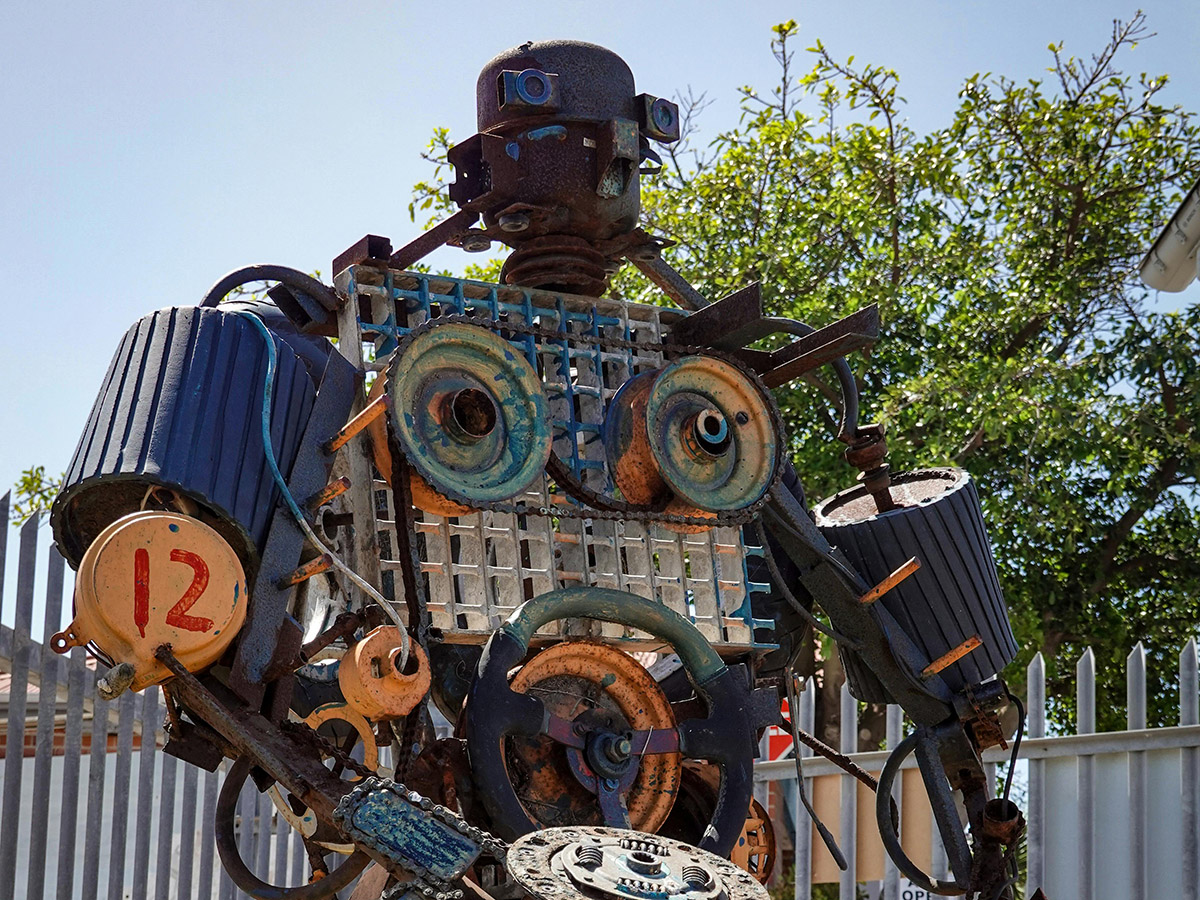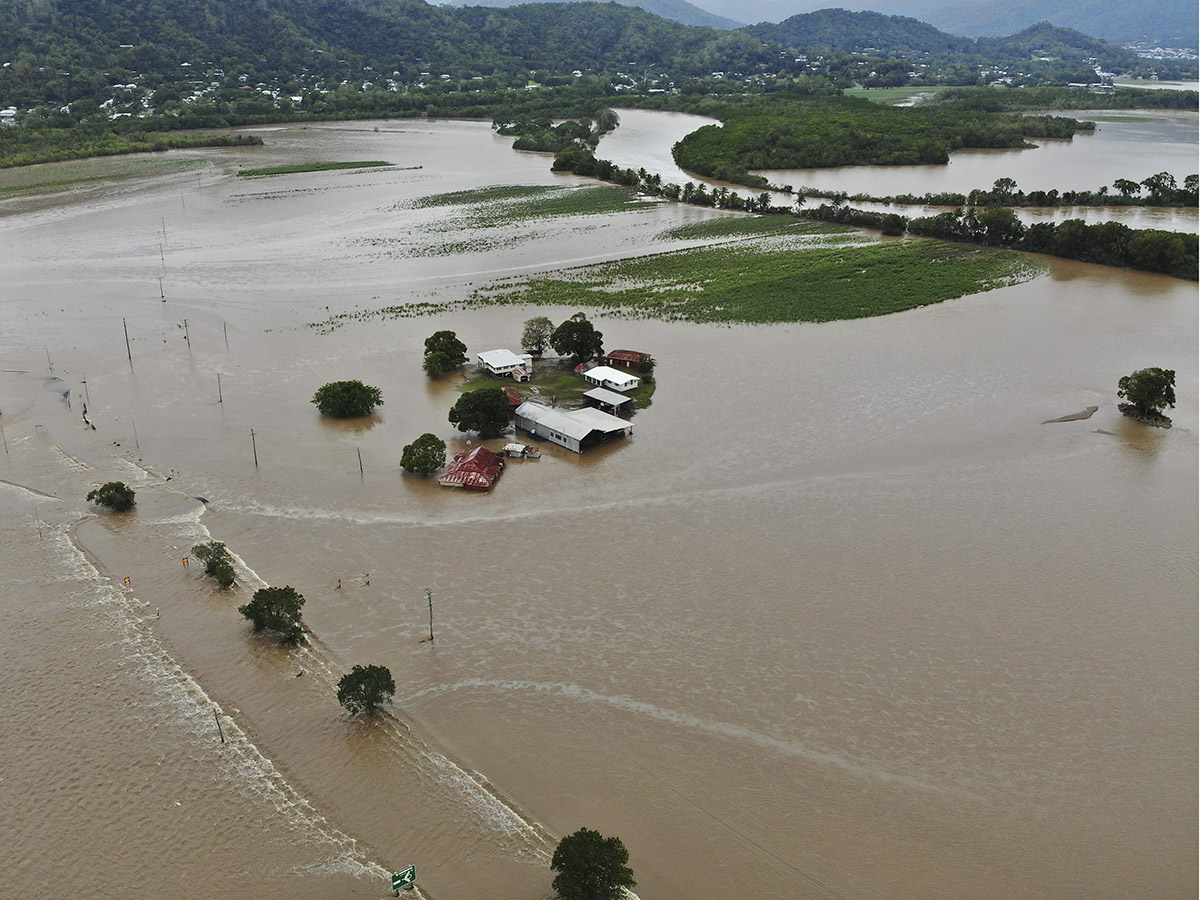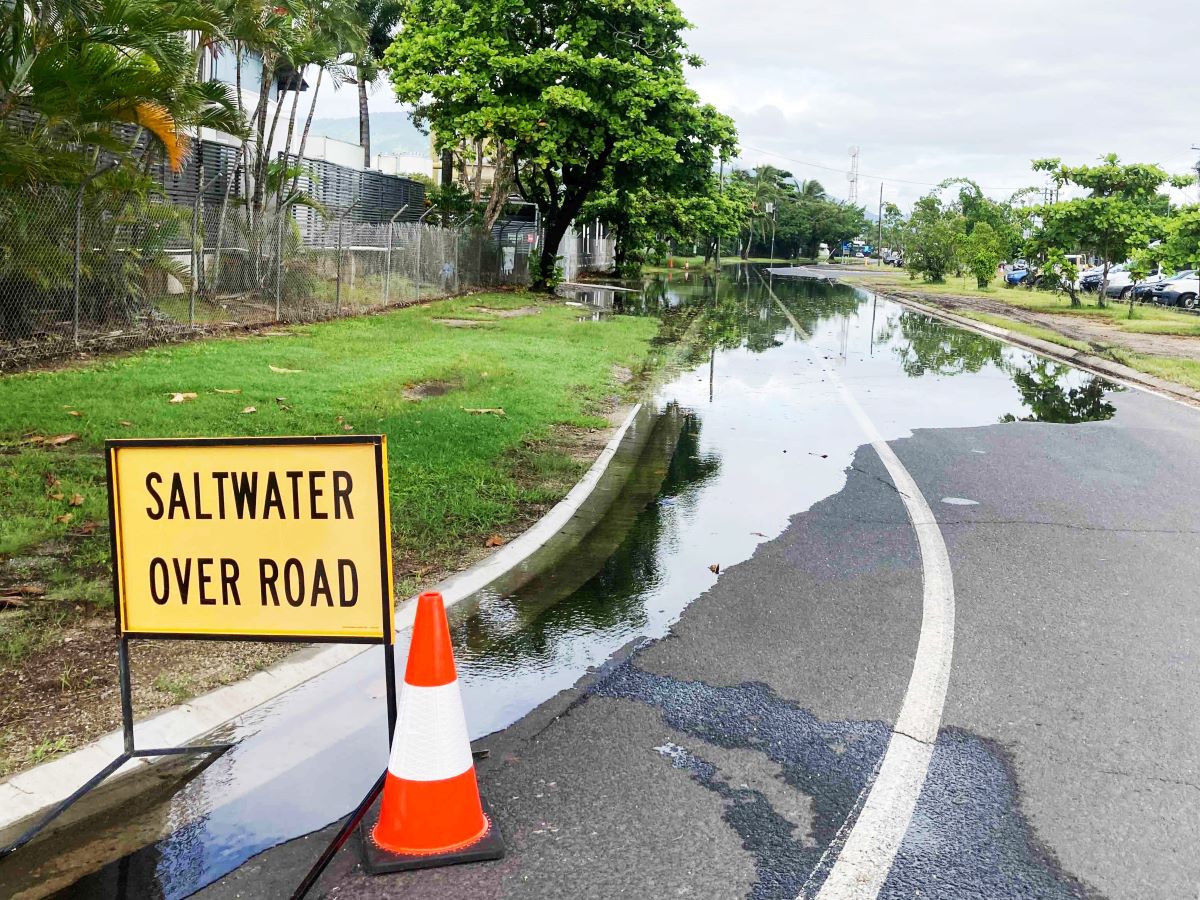First People's history & languages
Cairns Regional Council acknowledges and pays our respects to the Traditional Custodians of our region, the Djabugay; Yirrganydji; Buluwai, Gimuy Walubara Yidinji; Mandingalbay Yidinji; Gunggandji; Dulabed and Malanbara Yidinji; Bundabarra and Wadjanbarra Yidinji; Wanyurr Majay; Mamu and NgadjonJii peoples. We extend this respect to all elders past, present and future, and other First Peoples within our region.
Two large interpretive display panels on the Cairns Esplanade tell the story of the Traditional Owners of the area today known as Cairns. The text on these panels is reproduced below.
- The first panel describes the culture and history of the Yirrganydji people.
- The second panel is a welcome from the Yidinji people, and features information on Yidinji fighting shields, the King of Cairns, and the Cassowary (Gindaja).
Yirrganydji culture and history
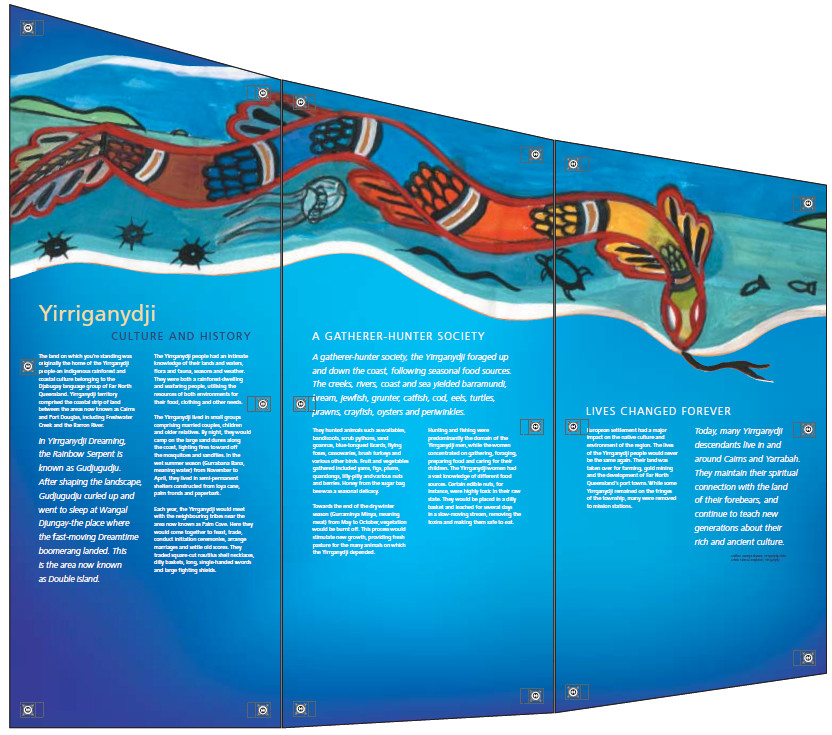
The land on which you’re standing was originally the home of the Yirrganydji people-an indigenous rainforest and coastal culture belonging to the Djabugay language group of Far North Queensland. Yirrganydji territory comprised the coastal strip of land between the areas now known as Cairns and Port Douglas, including Freshwater Creek and the Barron River.
In Yirrganydji Dreaming, the Rainbow Serpent is known as Gudjugudju. After shaping the landscape, Gudjugudju curled up and went to sleep at Wangal Djungay-the place where the fast-moving Dreamtime boomerang landed. This is the area now known as Double Island.
The Yirrganydji people had an intimate knowledge of their lands and waters, flora and fauna, seasons and weather. They were both a rainforest-dwelling and seafaring people, utilising the resources of both environments for their food, clothing and other needs.
The Yirrganydji lived in small groups comprising married couples, children and older relatives. By night, they would camp on the large sand dunes along the coast, lighting fires to ward off the mosquitoes and sandflies. In the wet summer season (Gurrabana Bana, meaning water) from November to April, they lived in semi-permanent shelters constructed from loya cane, palm fronds and paperbark.
Each year, the Yirrganydji would meet with the neighbouring tribes near the area now known as Palm Cove. Here they would come together to feast, trade, conduct initiation ceremonies, arrange marriages and settle old scores. They traded square-cut nautilus shell necklaces, dilly baskets, long, single-handed swords and large fighting shields.
A gatherer-hunter society
A gatherer-hunter society, the Yirrganydji foraged up and down the coast, following seasonal food sources. The creeks, rivers, coast and sea yielded barramundi, bream, jewfish, grunter, catfish, cod, eels, turtles, prawns, crayfish, oysters and periwinkles.
They hunted animals such as wallabies, bandicoots, scrub pythons, sand goannas, blue-tongued lizards, flying foxes, cassowaries, brush turkeys and various other birds. Fruit and vegetables gathered included yams, figs, plums, quandongs, lilly-pilly and various nuts and berries. Honey from the sugar bag bee was a seasonal delicacy.
Towards the end of the dry winter season (Gurraminya Minya, meaning meat) from May to October, vegetation would be burnt off. This process would stimulate new growth, providing fresh pasture for the many animals on which the Yirrganydji depended.
Hunting and fishing were predominantly the domain of the Yirrganydji men, while the women concentrated on gathering, foraging, preparing food and caring for their children. The Yirrganydji women had a vast knowledge of different food sources. Certain edible nuts, for instance, were highly toxic in their raw state. They would be placed in a dilly basket and leached for several days in a slow-moving stream, removing the toxins and making them safe to eat.
Lives changed forever
European settlement had a major impact on the native culture and environment of the region. The lives of the Yirrganydji people would never be the same again. Their land was taken over for farming, gold mining and the development of Far North Queensland's port towns. While some Yirrganydji remained on the fringes of the township, many were removed to mission stations.
Today, many Yirrganydji descendants live in and around Cairns and Yarrabah. They maintain their spiritual connection with the land of their forebears, and continue to teach new generations about their rich and ancient culture.
The Yidinji people
Bilan gudan njundu Yidin Yabanday, Yidi Nalan nudjun: Welcome to Yidinji Country, on behalf of the Yidinji Elders
The Yidinji Yabanday (tribal land boundary) covered a large area from the Barron River in the north to the Russell River in the south, east to the Murray Prior Range and west to Tolga. The Yidinji people had 8 clans who were custodians of the tribe’s estate.
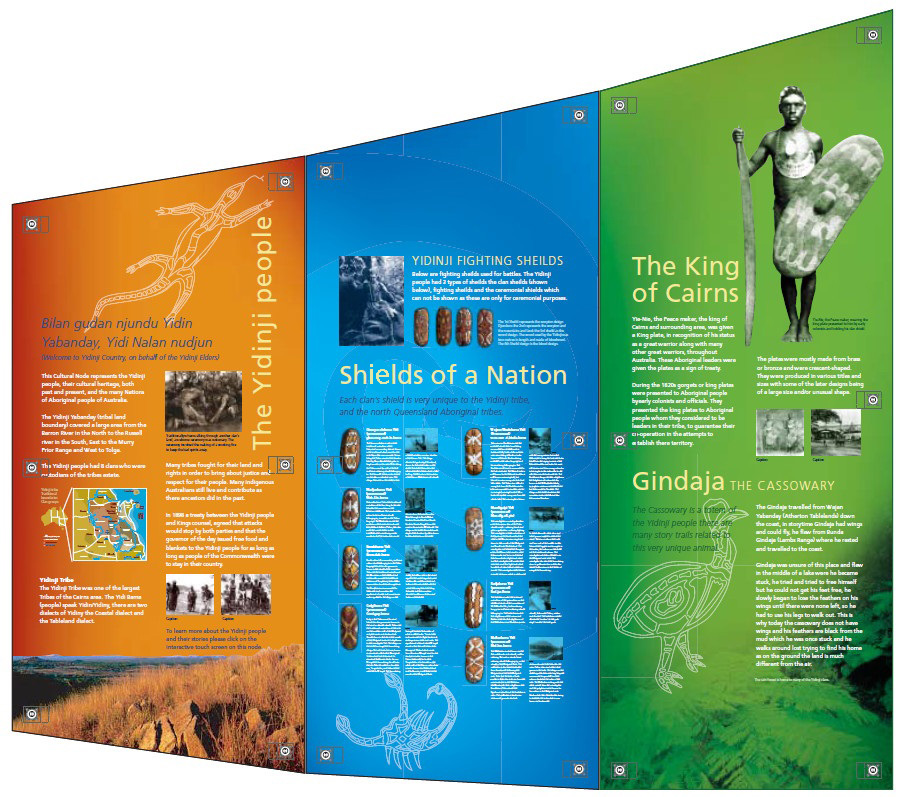
Yidinji Tribe
The Yidinji Tribe was one of the largest tribes of the Cairns area. The Yidi Bama (people) speak Yidin/Yidiny. There are two dialects of Yidiny: the Coastal dialect and the Tableland dialect.
Many tribes fought for their land and rights in order to bring about justice and respect for their people. Many Indigenous Australians still live and contribute as their ancestors did in the past.
In 1898, a treaty between the Yidinji people and King’s Counsel agreed that attacks would stop by both parties and that the governor of the day issued free food and blankets to the Yidinji people for as long as long as people of the Commonwealth were to stay in their country.
Shields of a Nation: Yidinji fighting shields
Each clan’s shield is unique to the Yidinji tribe, and the north Queensland Aboriginal tribes. The Yidinji people had 3 types of shields: the clan shields, fighting shields and the ceremonial shields (which are only for ceremonial purposes).
Gimuy-walubarra Yidi
(pronounced) ghee-moy-wah-lu-burra
The Gimuy-walubarra yidi are the traditional custodians of the Cairns and surrounding district. Gimuy is the traditional place name for the area Cairns City now occupies. Gimuy being the Yidiny name of the slippery blue fig (ficus albipila) that grew in large number in this area. Walu being the Yidiny name for side of the hill and barra meaning people belonging to. The Gimuy-Walubarra clan estate can be seen on adjacent map. The design featured on the shield is that of the Australian scorpion a totem of the Gimuy Yidi. The design depicts the grub stage (djumbun), shown by the white areas on the shield.The shield featured is the identical shield of that which is held by King Yie-Nie who is the ancestor of the Gimuy-Walubarra yidi people.
Wadjanbarra Yidi
(pronounced) Wah-Gin-burra
The wadjanbarra Yidi are the traditional custodians of the low lying forest area between the mountains on the Atherton tablelands. The name wadjan means forest and barra people belonging to, as spoken in the Yidiny language. The Wadjanbarra were the protectors of the rainforest and spoke the tableland dialect of Yidiny, they also spoke the coastal dialect as they travelled to the coast during winter months by the Yidi trails which carved its way down the coast from Giri (Kiari) through to Bunda Walpa Gindajay (Lambs Head) and Bunda Gindajay (Lambs Range) down the coast to Girriwanday (Whiterock). The design on the shield depicts the moth stage of the djumbun (grub) as shown by the white areas on the shield.
Bundabarra Yidi
(pronounced) Boon-dah-burra
Bunda means hill or mountain, and barra means people belonging to in the Yidiny language hence this clan group was known as the people of the mountains. They were the traditional custodians of the Mountains on the tableland and traditionally occupied the tablelands area around Yungabarra (early settlers’ pronunciation bundabarra/ yungabarra). The Bundabarra was surrounded by freshwater and mountains the significance of water and mountains as such is signified by the design on the shield, the yellow area in the centre signified the water bag which were traditionally made from bark and hollow tree trunks sealed with the native bees wax, the white being the water and the mountains depicted in yellow on the top and bottom of the shield.
Gulgibarra Yidi
(pronounced) Gool-gey-burra
Gulgi is the Yidiny word for sand hence this clan group was known as the sand or seaside people. They were the traditional custodians of the area on the southern side of the Mulgrave river,the sandy river banks which flowed down to the sea at the mouth of the Mulgrave and were neighbours to the mandigalpi Yidi. The design on the shield is wangal the boomerang design.The yidi had what was known as storytime unlike other Aboriginal Tribes which had dreamtime. In storytime Gulibunjay threw his son Wangal the boomerang far off into the sea.Then he picked up his other son, Yirrgaybalan, and followed the path left by Wangal. The boomerang (wangal) entered the waters of what is called today "Trinity Inlet and continued its flight landwards striking various trees and rocks. The significance of those places Wangal struck is that they still retain their Aboriginal (Yidiny) place names from this story.Wangal came to rest at what is today known as the Cairns esplanade his brother Yirrgaybalan is by his side on the other side of the Barron river what’s is today known has Reddin Island and Gulibunjay, is still there at the mouth of the Mulgrave River.
Wujnur/Bindabarra Yidi
(Pronounced) won-new-ri-binda-bu
The wujnur or Bindabarra were the waterfall people their home being surrounded by waterfalls such as Joshepine Falls, Fishery Falls and their main camp being at Binda or today known as Babinda. (Binda meaning waterfall in the yidiny language and barra meaning belonging to.)
The Bindabarra yidi home is surrounded by the lush rainforest. The Babinda area is well known for the Babinda Boulders, a well-known swimming hole - but beware, as many young men’s lives have been taken. The Yidiny story tells of a young lady from the Bindabarra clan who was promised to another man by an arranged marriage but she fell in love with another young man from the nearby tribe. She was caught in liaison with the young warrior but as the elders tried to bring her back she threw herself into the raging torrents of the Babinda boulders and today her spirit still remains and if any young men who are strangers to this area walks by she calls them into the river with her. The Bindabarra along with their neighbours the Gulgibarra yidi who were also known as the Bellenden Ker blacks, an Anglican mission was establish here but later moved to Yarrabah. The design on the shield represents the mountains and waterfalls and also the scorpion Djumbun.
Mandigalpi Yidi
(pronounced) Mun-dig-ell-pie)
The mandigalpi or mandiguljarabay were the warrior clan of the Yidin people mandi – meaning hands and galpi or guljarabay – meaning fighting. The mandigalpi are the custodians of the lands on the easternside of the inlet to the Murray prior range and down to the mouth of the Mulgrave and Russel river (Badabadoo). The mandigalpi yidi helped the Kunganji when the Mamu tribe came to steal their women and to try and extend their boundaries a fight took place and the mandigalpi still protect that area ever since this fight took place hundreds of years before whiteman arrived. The mandigalpi shield depicts a sacred ceremony which is performed by their clan with other clans and tribal groups invited to attend the ritual. The story is about the turle and how one of the smaller turtles became the biggest and strongest in the ocean, the colours on the shield are the traditional colours. The mandigalpi were also referred to as the Mulgrave river tribe. The mandigalpi also share the boomerang story as gulibunjay lays in their clan estate. Gulibunjay was the father of wangal the boomerang.
Badjabarra Yidi
(pronounced) Bud-jar-Burra
The badjabarra were the traitional custodians of the grass plains on the tableland slopes of the mountains of Mt Bellenden Kerr, badja meaning long grass and barra meaning people belonging to. The badja barra were the neighbours of the mamu and Nadjan tribe also the neighbours of the Mallanbarra and Bindabarra yidin people, they spoke Yidiny, nadjon and djirribal. The badjabarra shield depicts the 'jumbun' at the grub stage 'minderi' the tree grub.
Mallanbarra Yidi
(pronounced) Mul-lun-burra
The Mallanbarra were known as the flat rock/stoney river people, mallan meaning flat rock or stoney barra meaning people belonging to, or the people of the Mulgrave River. The mallanbarra clan estate extended from Gordonvale following the Mulgrave and the little Mulgrave river. They had the best of both worlds as their clan area ran from the coast and west to the Atherton tablelands with their neighbours the Bundabarra Yidin people the Ngadjun-ji people and the badjabarra yidin. The mallanbarra have many ceremonial grounds of which ceremonies were held between the many Yidiny clans and other tribal groups in the area. The design on the shield signifies the water bag (dogobil pronounced do-goo-bill) and the colours represent the ochar of the area. The Mallanbarra along with the other coastal clans the mandiigalpi and the gulgibarra were known by Europeans as the Mulgrave river blacks which they feared when trying to establish the area which is now known as Gordonvale.
The King of Cairns
Yie-Nie, the Peace-maker, the King of Cairns and surrounding area, was given a King plate, in recognition of his status as a great warrior along with many other great warriors, throughout Australia. These Aboriginal leaders were given the plates as a sign of treaty. During the 1820s, gorgets or king plates were presented to Aboriginal people by early colonists and officials. They presented the king plates to Aboriginal people whom they considered to be leaders in their tribe, to guarantee their co-operation in the attempts to establish their territory. The plates were mostly made from brass or bronze and were crescent-shaped. They were produced in various titles and sizes with some of the later designs being of a large size and/or unusual shape.
Gindaja the Cassowary
The Cassowary is a totem of the Yidinji people. There are many story trails related to this very unique animal.
The Gindaja travelled from Wajan Yabanday (Atherton Tablelands) down the coast, in storytime Gindaja had wings and could fly, he flew from Bunda Gindaja (Lambs Range) where he rested and travelled to the coast. Gindaja was unsure of this place and flew in the middle of a lake were he became stuck, he tried and tried to free himself but he could not get his feet free, he slowly began to lose the feathers on his wings until there were none left, so he had to use his legs to walk out.
This is why today the cassowary does not have wings and his feathers are black from the mud which he was once stuck and he walks around lost trying to find his home as on the ground the land is much different from the air.
Last Updated: 19 November 2022
Latest News > All News
Students invited to create art from waste
School-aged students are being invited to create a sculpture, installation work, image collage, functional furniture, or wearable project using used...
Help shape our Flood Recovery Plan
In response to the recent severe flooding caused by ex-Tropical Cyclone Jasper that has impacted our community, Cairns Regional Council...
King tides expected to impact Cairns this week
Residents are advised that king tides will be experienced in Cairns from Wednesday 17 April through to Saturday 20 April...
